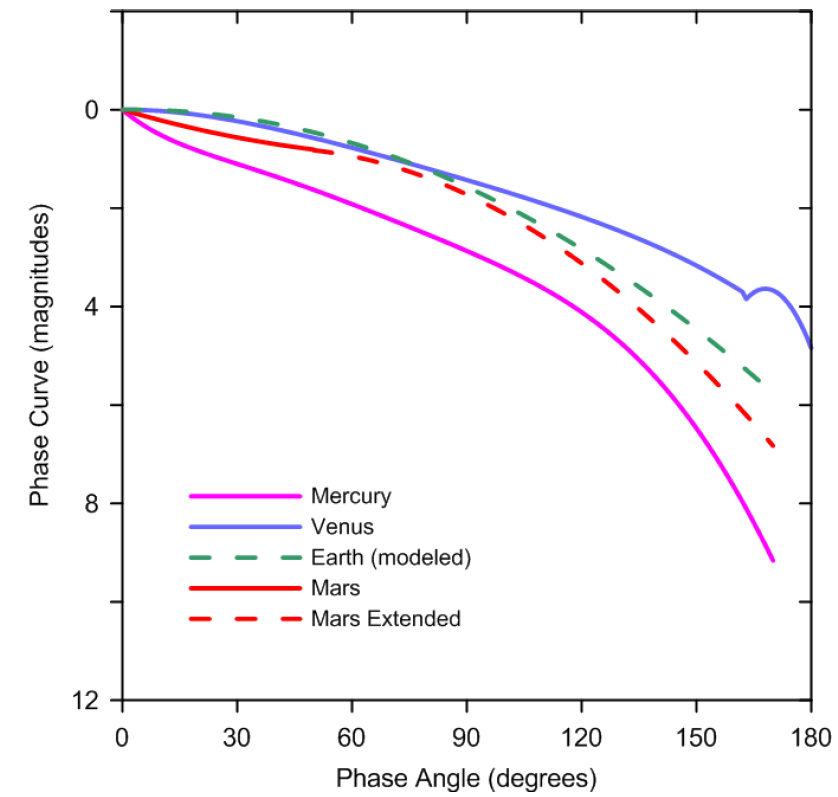NEW
The magnitude of the Moon is in many cases approximated by using the formula of Allen (1973, page 144), as for instance used by Schaefer (2000, page 129). It is known that Allen's formula is not valid for large Phase Angles (>150°). A formula for a larger range is needed if one wants to perform e.g naked eye First/Last Crescent predictions (Phase Angles upto 176°). A pity that such a range is not yet (status 2022) covered by empirical data, e.g. not in the paper of Mallama&Hilton (2018). O this page a Moon magnitutde formula is proposed.
Mallama&Hilton (2018, Fig. 1) have phase (relative magnitude)
curves for the inner planets, see below:

As above can be seen: The behavior of
inner planets' phase curve is similar for all of them. But this
behavior is not similar to what Russell (1916, page 117) proposes
for the Moon, which is: "the assumption that the moon’s light
continues to vary nearly as the cube of the elongation from the
sun is probably as good a guide as any".
The question is: Is it correct to say 'probably as good a guide as
any' (as stated in 1916)? Or is it better to look at for
analogical ideas from the inner planets' magnitude (of 2018).
In below graphs some tentative Moon's phase curves (black) are
shown: The well-known Allen's phase curve (Moon - Allen) is
the continuous black line. Russells' mean magnitude (Russell,
1916, Table III) is shown by the black triangles (Moon -
Russell). A possible extrapolation of Allen is porposed by
Segura González (2021, page 5) based on the above statement of
Russel's cube of elongation; this results in the black dotted line
(Moon - Allen&Russell).

PA=abs(PA)
Comp = 5 * log10(r * R)
If PA<=105.4065
Magn=‑21.62+0.026*PA+0.000000004*PA^4+Comp
else
Magn=‑5.26452‑2.33551*log10((180-PA)^3))+Comp
The Moon is much closer to the Earth
than Mercury, while Mercury is closer to the Sun and has a
smoother surface than the Moon (Mallama&Wang&Howard, 2002,
page 260); it is not yet known (status 2022) how the Moon's
magnitude behaves close to 180°. The smoother surface of Mercury
could mean a relative brightness/magnitude that is higher/lower
for Mercury than for the Moon.
When including the seen behavior of the inner planets (behavior
seen in the above graph (Mallama, 2018, Fig. 1)) in Allen's
magnitude of the Moon; Reijs derived the black dashed line (Moon
- Allen&Mercury). The adjusted magnitude formula Moon
- Allen&Mercury becomes:
PA=abs(PA)
Comp = 5 * log10(r * R)
If PA<=125
Magn=‑21.62+0.026*PA+0.000000004*PA^4+Comp
else
Magn=‑21.8164+0.06328*PA‑0.0016336*PA^2+0.000033644*PA^3‑0.00000034265*PA^4+0.0000000016893*PA^5‑0.0000000000030334*PA^6+Comp
So another formula is needed, like Allen's magnitude plus Samaha's formula (see Segura González [2022], formula (3)) which has a luminance that decreases towards 180 phase angle:
PA=abs(PA)
Comp = 5 * log10(r * R)
If PA<=147.1385465
Magn=‑21.62+0.026*PA+0.000000004*PA^4+Comp
else
Magn=-4.5444-2.5*log10((180-a)^3))+Comp
This has also been tested.
Remember that these magnitude formula are not empirical formulas. If you know such an empirical formula, let me know.
Allen, C.W.: Astrophysical quantities. London, The Athlone press
1973.
Segura González, Wenceslao: Danjon limit: Helwan method. pp.
1-117 2021.
Segura González, Wenceslao: Magnitude
of the Moon at large phase angles. In: (2022).
Mallama, Anthony et al.: Photometry of Mercury from SOHO/LASCO and
Earth: The phase function from 2 to 170°. In: Icarus 155
(2002), pp. 253-264.
Mallama, Anthony and James L. Hilton: Computing apparent planetary
magnitudes for The Astronomical Almanac. pp. 1-64 2018.
Russell, Henry Norris: The stellar magnitudes of the Sun, Moon and
planets. In: American Astronomical Society 43, pp. 103-129.
Schaefer, Brad E.: New methods and techniques for
historical astronomy and archaeoastronomy. In:
Archaeoastronomy: The journal of astronomy in culture XV
(2000), pp. 121-135.